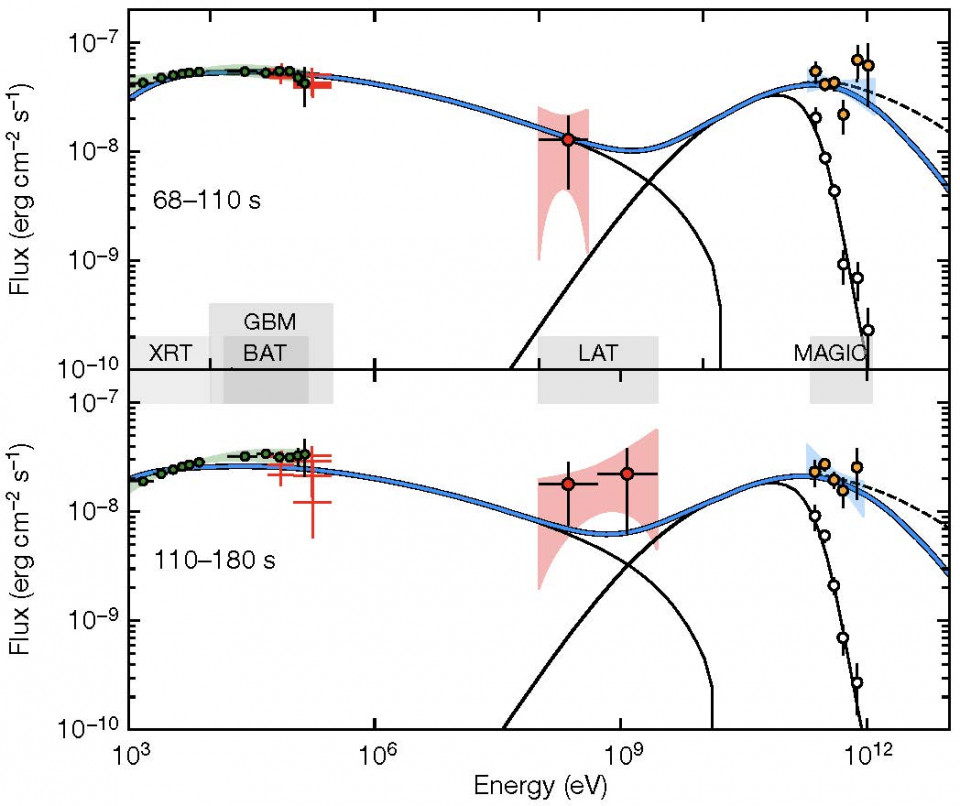Discovery of teraelectronvolt photons from gamma-ray bursts: A new window for exploring the most luminous explosions in the Universe
On January 14, 2019, TeV gamma rays (photons with energies a trillion times that of visible light) were clearly detected for the very first time from a gamma-ray burst (GRB; dubbed GRB 190114C) by the MAGIC telescopes. The very high energy of the individual photons as well as the high power of the total signal demonstrate that they must be produced by a physical process that is distinct from the previously known afterglow synchrotron radiation. Combined with extensive multiwavelength data obtained by a large number of observatories from the radio to GeV bands, the most likely mechanism is judged to be "inverse Compton” radiation associated with the afterglow, whereby some synchrotron photons are significantly boosted in energy by colliding with high-energy electrons [1]. These findings were reported in two papers published on Nov. 21 in the journal Nature, one authored by the MAGIC Collaboration where Susumu Inoue of iTHEMS is the first corresponding author [2], and the other co-authored by a large team of astronomers including the MAGIC Collaboration [3].
Caption for the figure:
Spectra of GRB 190114C in the X-ray to TeV gamma-ray energy range during two time intervals (top: 68-110 seconds after the beginning of the GRB; bottom: 110-180 seconds ibid.). Markers reflect data: white circles are observed MAGIC data; orange circles are MAGIC data corrected for intergalactic propagation effects. Curves are theoretical models: thin solid curves are synchrotron emission and inverse Compton emission shown separately; thick blue curves are their sum; dashed curves are inverse Compton emission when neglecting internal absorption effects.
- Background:
- Gamma-ray bursts (GRBs) are the most luminous cosmic sources of electromagnetic radiation, believed to originate from fast jets of plasma that are ejected by newly-born black holes or neutron stars at cosmological distances. GRBs begin with a prompt, bright flash of MeV gamma rays (photons with energies a million times that of visible light), lasting seconds to minutes. They are followed by longer-lasting “afterglow” emission that spans a broader range of energies, from the radio band up to GeV gamma rays (ibid. a billion times that of visible light). The afterglow is widely accepted to be synchrotron radiation from high-energy electrons, accelerated in relativistic shock waves induced by the jets. Emission at even higher energies had been theoretically predicted, but had never been observationally confirmed, despite decades of dedicated searches by gamma-ray astronomers.
- Implications and prospects:
- The newly revealed inverse Compton component provides new information on the physical conditions of the afterglow, which was not available through observations of the synchrotron component alone. Despite the earlier non-detections, various considerations indicate that GRB 190114C was not a peculiar event. TeV emission from GRBs may actually be common, and detectable as long as the observing conditions are suitable. The prospects will be greatly improved with the Cherenkov Telescope Array, a new gamma-ray astronomy facility currently under construction. Further observations of GRB TeV emission should bring forth crucial new insight into the physics of not only GRB afterglows and relativistic shock waves, but also of the jets and the prompt emission, whose origins are still poorly understood.


